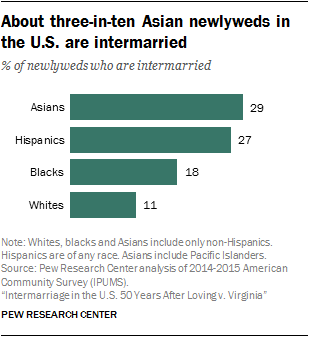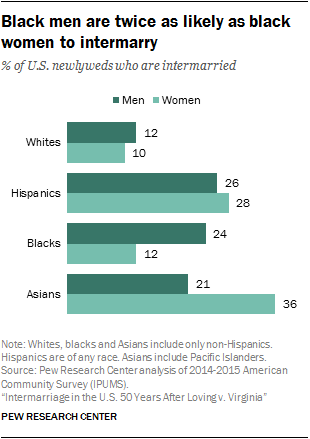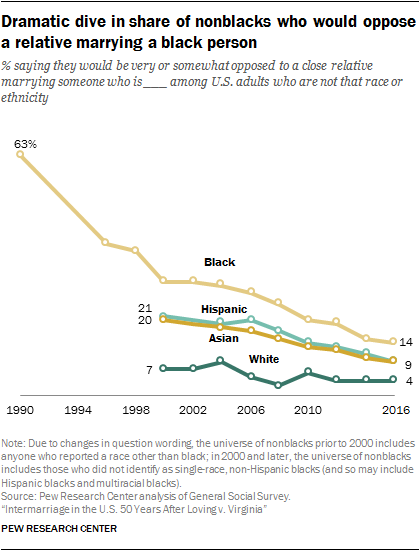DRAMATIC RISE IN INTERMARRIAGES – PEW RESEARCH by Gretchen Livingston and Anna Brown
One of the indicators that American culture is uniting the races in shared life is not only the number of intermarriages but also in the increased support of these marriages. In a recent PEW study the increase in both has been found to be significant in the last twenty years in the United States. The authors are GRETCHEN LIVINGSTON AND ANNA BROWN
In part the research has found:
In 2015, 17% of all U.S. newlyweds had a spouse of a different race or ethnicity, marking more than a fivefold increase since 1967, when 3% of newlyweds were intermarried, according to a new Pew Research Center analysis of U.S. Census Bureau data.2 In that year, the U.S. Supreme Court in the Loving v. Virginia case ruled that marriage across racial lines was legal throughout the country. Until this ruling, interracial marriages were forbidden in many states.
More broadly, one-in-ten married people in 2015 – not just those who recently married – had a spouse of a different race or ethnicity. This translates into 11 million people who were intermarried. The growth in intermarriage has coincided with shifting societal norms as Americans have become more accepting of marriages involving spouses of different races and ethnicities, even within their own families.
The most dramatic increases in intermarriage have occurred among black newlyweds. Since 1980, the share who married someone of a different race or ethnicity has more than tripled from 5% to 18%. White newlyweds, too, have experienced a rapid increase in intermarriage, with rates rising from 4% to 11%. However, despite this increase, they remain the least likely of all major racial or ethnic groups to marry someone of a different race or ethnicity.
 Asian and Hispanic newlyweds are by far the most likely to intermarry in the U.S. About three-in-ten Asian newlyweds3 (29%) did so in 2015, and the share was 27% among recently married Hispanics. For these groups, intermarriage is even more prevalent among the U.S. born: 39% of U.S.-born Hispanic newlyweds and almost half (46%) of U.S.-born Asian newlyweds have a spouse of a different race or ethnicity.
Asian and Hispanic newlyweds are by far the most likely to intermarry in the U.S. About three-in-ten Asian newlyweds3 (29%) did so in 2015, and the share was 27% among recently married Hispanics. For these groups, intermarriage is even more prevalent among the U.S. born: 39% of U.S.-born Hispanic newlyweds and almost half (46%) of U.S.-born Asian newlyweds have a spouse of a different race or ethnicity.
For blacks and Asians, stark gender differences in intermarriage
 Among blacks, intermarriage is twice as prevalent for male newlyweds as it is for their female counterparts. While about one-fourth of recently married black men (24%) have a spouse of a different race or ethnicity, this share is 12% among recently married black women.
Among blacks, intermarriage is twice as prevalent for male newlyweds as it is for their female counterparts. While about one-fourth of recently married black men (24%) have a spouse of a different race or ethnicity, this share is 12% among recently married black women.
There are dramatic gender differences among Asian newlyweds as well, though they run in the opposite direction – Asian women are far more likely to intermarry than their male counterparts. In 2015, just over one-third (36%) of newlywed Asian women had a spouse of a different race or ethnicity, compared with 21% of newlywed Asian men.
In contrast, among white and Hispanic newlyweds, the shares who intermarry are similar for men and women. Some 12% of recently married white men and 10% of white women have a spouse of a different race or ethnicity, and among Hispanics, 26% of newly married men and 28% of women do.
A more diverse population and shifting attitudes are contributing to the rise of intermarriage
The rapid increases in intermarriage rates for recently married whites and blacks have played an important role in driving up the overall rate of intermarriage in the U.S. However, the growing share of the population that is Asian or Hispanic, combined with these groups’ high rates of intermarriage, is further boosting U.S. intermarriage overall. Among all newlyweds, the share who are Hispanic has risen by 9 percentage points since 1980, and the share who are Asian has risen 4 points. Meanwhile, the share of newlyweds who are white has dropped by 15 points.
 Attitudes about intermarriage are changing as well. In just seven years, the share of adults saying that the growing number of people marrying someone of a different race is good for society has risen 15 points, to 39%, according to a new Pew Research Center survey conducted Feb. 28-March 12, 2017.
Attitudes about intermarriage are changing as well. In just seven years, the share of adults saying that the growing number of people marrying someone of a different race is good for society has risen 15 points, to 39%, according to a new Pew Research Center survey conducted Feb. 28-March 12, 2017.
The decline in opposition to intermarriage in the longer term has been even more dramatic, a new Pew Research Center analysis of data from the General Social Survey has found. In 1990, 63% of nonblack adults surveyed said they would be very or somewhat opposed to a close relative marrying a black person; today the figure stands at 14%. Opposition to a close relative entering into an intermarriage with a spouse who is Hispanic or Asian has also declined markedly since 2000, when data regarding those groups first became available. The share of nonwhites saying they would oppose having a family member marry a white person has edged downward as well.
To read more of the original post click here.
